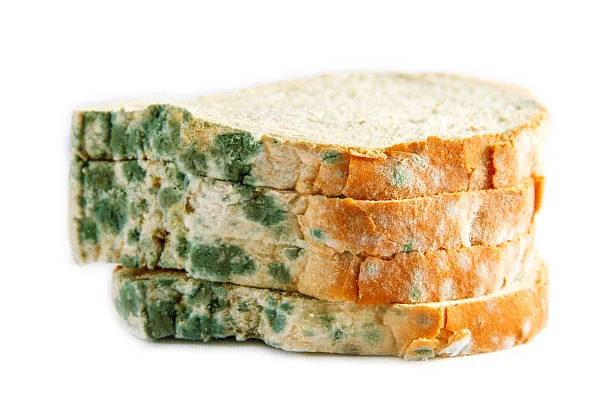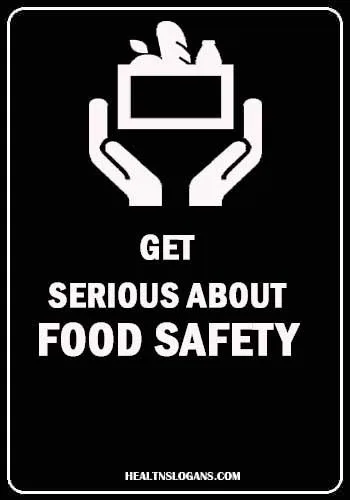Food spoilage
Food spoilage is the deterioration of a food’s physical and chemical characteristics, making it unsuitable for consumption. Food becomes spoiled when there is a foul odor coming from it. Bubbles start to form on the food’s surface in combination with this. There is a foul smell that is detectable. When molds are visible in food, such as in molds of stale bread, that food is considered spoiled. Food is spoiled when it changes in color, like orange juice turning dark orange, or when it smells rancid, like oil, or when it tastes bad. Causes and Prevention Strategies for Food Spoilage will be studied in this article.

Classification of foods by the ease of spoilage
Foods can be divided into three groups according to the ease of spoilage:
Stable or nonperishable foods: These foods are spoil when they are handled carelessly. Stable or nonperishable and include sugar, flour, dry beans, and other product.
Semi perishable Food: If carefully stored and handled, semi perishable foods can be kept in perfect condition for up to a year. e.g., potatoes, some varieties of apples, waxed rutabagas, and nutmeats.
Perishable foods: Perishable foods are the most important everyday foods that can spoil quickly if not given special preservation methods. e.g. meats, fish, poultry and most fruits and veggies, as well as eggs and milk.
Learn More on
Food spoilage can be caused by biological, chemical, or physical factors, respectively. Development and activity of microorganisms including bacteria, yeast, and mold; the action of food enzymes; and harm caused by pests, insects, and rodents, among other things, are examples of biological causes. Chemical reactions inside food materials and reactions with air and light are examples of chemical causes. Temperature and physical abuse are examples of physical causes.
All of these factor acts together. Food spoilage can occur simultaneously in a field or a warehouse due to germs, insects, and light. The growth and activity of bacteria as well as the chemical reactions of food enzymes are affecting by heat, moisture, and air at the same time.
1. Spoilage due to growth and activity of microorganisms
Microorganisms found in the air, soil, water, and on foods cause the majority of significant deteriorative changes in food. Our food supply becomes unsuitable for consumption as a result of their using it as a source of nutrients for their own development, causing food to deteriorate. Microbes may contaminate food in a variety of ways, including by growing, consuming nutrients, producing enzymatic changes, adding off flavors, breaking down products, and synthesizing new chemicals. Bacteria, yeasts, and molds are the three main kinds of microorganisms that cause food deterioration.
Bacterial growth is influenced by the kind of food, temperature, pH, moisture, and oxygen. Bacteria are the most common causes of food spoiling and are much more difficult to get rid of than yeast and mold. Each kind of bacteria has a definite range of food requirements. The amount of moisture in food has a big impact on whether or not bacteria can grow there. More moisture is required by bacteria than by yeasts or molds. While certain bacteria may also survive in acidic or alkaline environments, most bacteria grow best at a neutral pH. As all bacteria have an acid sensitivity, they may be quickly destroyed in an acidic pH environment at a boiling water temperature. In order to eliminate bacteria, low acid foods like maize, peas, beans, and all vegetables other than tomatoes must be processed at a higher temperature (116°C) under steam pressure than high acid foods (such as all fruits, tomatoes, pickles, etc.) that are treated at 100°C.
Because there are moist heat-resistant bacteria in the soil, root vegetables must be handled carefully during preparation and processing. Foods stored in cans become spoiled due to Clostridium botulinum.Certain bacteria are very helpful when processing food. For example, lactic acid is produced by lactic acid bacteria such as Lactobacillus plantarum, Pediococcus cerevisiae, Leuconostoc mesenteroides, etc. through the fermentation of carbohydrates, as well as by aerobic bacteria like Acetobacter acetic, which is used in the production of vinegar.
In order to grow, yeasts need less moisture and an acidic pH; they cannot grow in an alkaline media. In low-concentration sugar solutions at moderate temperatures (25–30°C), yeasts can grow. Most yeasts typically won’t grow on medium that contain more than 65% sugar or 0.5% acetic acid. Most yeast species may be destroyed by heating at 60°C for a short time. Yeast spores and cells can be successfully destroyed by boiling.
Certain yeasts are very helpful in producing items like vinegar, bread, beer, and wine. Fruits and fruit products’ fermentation is caused by yeast. When yeasts develop on fruits, juices, squashes, sherbet, honey, etc., they are undesirable because they damage the appearance, flavor, texture, and wholesomeness of fruits and fruit products.
Molds need a sufficient amount of warmth, moisture, and air to grow and do best in enclosed, damp, and dark environments. Jam, jelly, preserves, and other sweet foods are favorites of molds because they contain sugar. While they may grow in a wide pH range (2 to 8.5), the majority do well in an acidic environment. therefore, they grow on pickles, juices, etc. They may grow on a wide range of foods, especially when the air, temperature, and humidity are favorable. Their growth can be seen only on the surface of food. The majority of molds are heat-sensitive and die at 60°C after 30 minutes of heating. Mold and its spores are quickly destroyed by boiling.
2. Spoilage Due to Chemical Reactions
Atmospheric oxygen and sunlight are necessary for chemical reactions to occur. Lipid oxidation and non-enzymatic browning are two significant chemical changes that take place during the preparation and storage of fruits and vegetables that degrade sensory quality, color, and flavor.
Light, oxygen, a high temperature, the presence of iron and copper, and water activity all impact lipid oxidation. The amount of lipid oxidation or rancidity in foods can be greatly reduced if these parameters are under control.
One of the main causes of degradation is non-enzymatic browning, which occurs when foods are cooked, boiled, stored, and concentrated or dried through Maillard, caramelization, and ascorbic acid oxidation. The Maillard process, which forms dark brown insoluble pigments when reducing sugars and amino acids react in the presence of heat. Sugars caramelize when they are exposed to intense heat and little moisture in the meal. Off-flavors are also produced when fatty acids are oxidized to other substances such aldehydes, ketones, alcohols, and esters.
3. Spoilage Due to Physical Factors
Food spoilage can also be brought on by physical factors like temperature, moisture, and pressure. Fruits and vegetables that are frozen, burned, dried, or bruised while being handled, stored, or transported induce physio-chemical processes that lead to food degradation.
Fruits and vegetables lose some of their color during food preparation and storage as a result of the chlorophyll degrading, rendering them a dull olive-brown color. When green beans and peas are dehydrated and packed in glass, the desired color is lost due to photo-oxidation. Foods that are frozen may have quality problems due to freezer-induced deterioration.

Food is valuable. Food waste can be reduced with the aid of preservation. Preventing food spoilage is the act of preserving food. Food preservation refers to the practice of preserving food using particular techniques. Food may be preserved in a variety of ways to be utilized later, whether it is cooked or raw. some methods of preservation are:
Freezing
The quickest, most convenient, and least time-consuming way to preserve food is through freezing. The majority of foods freeze well, with the exception of cooked starchy food like cooked noodles and rice, cream-based products, and vegetables with a high-water content. Enzymes, substances that aid in the plant’s ripening and maturing, are present in all fresh produce. Enzyme activity is slowed but not stopped during freezing. These enzymes have the potential to affect the flavor and color of foods stored in freezers if they are not inactivated. Additionally, freezing inhibits the growth of pathogenic germs but does not destroy them.
Canning
Many different foods may be preserved by the process of canning, which involves packing food in jars or cans and heating it carefully to a certain temperature. To maintain the food’s safety and quality, high heat inactivates enzymes and eliminates germs.
Boiling water bath methods
The boiling water technique is placing food in airtight jars that are heated, fully submerged in boiling water, and then cooked for a certain period of time. The jars cool when the process is finished, and a vacuum seal is formed. Acidic foods like tomatoes, jellies, and fruit are safe to use with this technique.
Pressure canning methods
Jars of food are placed in 2-3 inches of water in a specialized pressure cooker for pressure canning. Because of the existence of a bacteria called Clostridium botulinum, pressure canning is the only technique of meat, poultry, and seafood preservation that is completely safe. Particularly in low-oxygen and low-acid settings, Clostridium botulinum bacteria can develop spores that tolerate boiling temperatures and then generate deadly toxins when they start to mature. At least 240°F is required to kill them, which is a greater temperature than what boiling water reaches. Therefore, pressure canning at 240°F or above is the only way to get rid of these spores. For low-alkaline foods, use this technique.
Salting
Since ancient times, salt has been used to help ensure the safety of food. It requires very high salt concentrations (about 10% or more) to inhibit bacterial development, despite the fact that salt helps preserve food by lowering water content and inhibiting microbial cells. Beef jerky, pickles, and smoked salmon are just a few examples of foods that are preserved using salt.
Sweetening
Sugar has an osmotic affect when it is given to fresh meals like fruits and vegetables. This indicates that sugar reduces the water activity in the food by absorbing water from it. (aw). Reduced water activity in a food product indicates there are fewer free water molecules available for bacteria to develop and proliferate in. Bacteria require water to survive and reproduce. It produces an environment that inhibits bacteria survival and development.
Dehydration
One of the earliest and simplest ways of food preservation is drying (dehydrating) food. Dehydration is the process of removing moisture or water out of food. Foods become smaller and lighter when moisture is removed from them. Drying food is also a way of preserving for seasonal food for later use. Dehydration preserves food by lowering its moisture level, which inhibits the growth of the microbes that cause deterioration and slows down the enzymatic processes that occur within food. These occurrences work together to keep dry food from spoiling.
Reference
- http://joeldgreat.expertscolumn.com/article/causes-food-spoilage-and-its-prevention
- http://ecoursesonline.iasri.res.in/mod/page/view.php?id=19434
- https://www.toppr.com/guides/evs/mangoes-round-the-year/food-spoilage/
- https://www.longdom.org/open-access-pdfs/a-brief-note-on-food-spoilage-and-its-causes.pdf
- https://www.interesjournals.org/articles/causes-of-food-spoilage-and-methods-for-food-preservation-52464.html
- https://processfood.blogspot.com/2009/07/food-spoilage-and-physical-factors.html
- https://www.sciencedirect.com/topics/agricultural-and-biological-sciences/food-spoilage
- https://www.campdenbri.co.uk/services/food-spoilage.php
- https://www.open.edu/openlearncreate/mod/oucontent/view.php?id=194§ion=1.7.3
- https://extension.wvu.edu/food-health/home-food-preservation/canning/canning-process
- https://ohioline.osu.edu/factsheet/hyg-5341
- https://realgoods.com/blog/water-for-food-preservation-everything-you-need-to-know/
- https://www.verywellhealth.com/eat-it-with-a-grain-of-salt-1958878
- https://www.sugarnutritionresource.org/news-articles/sugar-as-a-preservative
- https://www.pubs.ext.vt.edu/content/dam/pubs_ext_vt_edu/348/348-597/348-597(FST-304NP).pdf